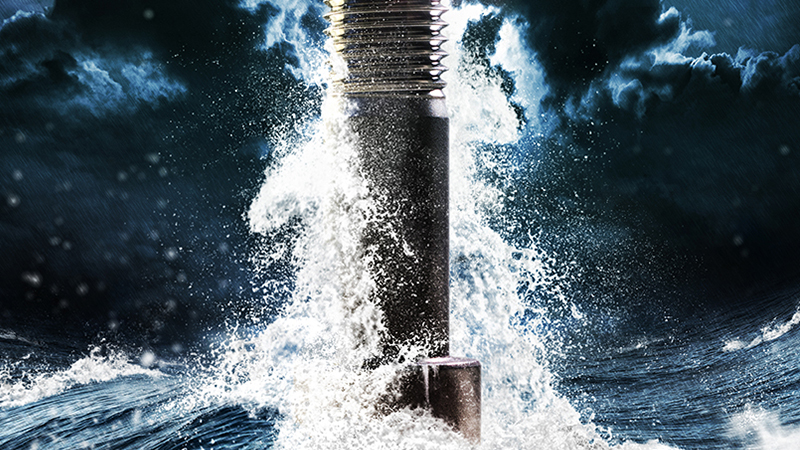
We have the expertise and product range to provide a safe, reliable and long-lasting fastener solution for every application and corrosive environment.
Corrosion resistance
The corrosion properties of a stainless steel are mainly determined by its ability to form a protective passive layer of chromium oxide. When this layer cannot be maintained, due to an overly aggressive environment, the metal will be exposed to the surrounding environment and corrosion will occur.
The Pitting Resistance Equivalent number (PRE)* gives a good indication of the pitting and crevice corrosion resistance as a function of the alloying content. The corrosion resistance of a stainless steel fastener is not only defined by the chemical composition of the steel, but by many other factors such as, fastening design, surface quality, stresses and the presence of crevices. Environmental factors such as the concentration of chloride ions, chemical composition of the corrosion environment, temperature, pH, pressure and oxidizing agents are also important to determine the material resistance and selecting the right material.
Most common forms of corrosion
General corrosion: Characterized by a uniform corrosion over the surface. It is therefore common to define a corrosion rate as mean metal lost per unit time, mm/year or milli-inch/year (mpy).
Pitting corrosion: Localized to a small area and creates pits in the metal. Pitting corrosion is often much more dangerous than general corrosion as a single pit can be the start of a failure.
Crevice corrosion: Same corrosion principle as pitting corrosion but occurs in crevices. Crevice corrosion can occur in concealed places such as small gaps and contact areas between parts and spaces where corrosive deposits can be retained. Correctly selected material in combination with good design and cleaning will reduce the risk of crevice corrosion.
Galvanic corrosion: Two different metals in the same corrosive environment, in which the less noble metal corrodes. The potential difference between the two metals produces a flow of electrons from the less noble metal (anodic) to the noble metal (cathodic). When the surface of the noble metal is large relative to the less noble metal, there is an increase in the corrosion rate of the less noble material. For example, carbon steel bolts in a stainless steel sheet have a higher corrosion rate than stainless steel bolts in a carbon steel sheet, when used in the same environment. Coupling different stainless steel grades is rarely a problem as the potential difference is too small.
Stress corrosion: Stress Corrosion Cracking (SCC) can occur when the metal is exposed to tensile stresses in a corrosive environment, often at elevated temperatures above 60°C. SCC is dangerous as it can lead to an unexpected sudden failure in normally ductile metals. The most common media type where SCC occurs is chloride containing solutions. Grades such as BUMAX Super Austenite, Super Duplex or Hyper Duplex are highly recommended in severe condition such as swimming pools, corrosive petrochemical applications and industrial environments.
Practical guidelines
- Evaluate the environment and the likelihood of accumulated deposits.
- Use a design that minimizes crevices and allows rain to wash away deposits.
- Use a stainless steel fastener with equivalent or higher corrosion resistance than the component being fastened.
- Avoid mixing materials with a large difference in electrode potential.
* PRE = % Cr + 3.3 x % Mo + 16 x % N
Corrosion resistance table
Material selection guide, contact your local BUMAX sales representative for more information.
| Grade | Urban | Marine, salt water | Hydrochloric acid at 50°C | Sulphuric acid at 50°C | ||||||
|---|---|---|---|---|---|---|---|---|---|---|
| High | Low | High | 0.1% | 1% | 2% | 3% | 1% | 10% | 30% | |
| BUMAX 88 | O | O | ⊗ | ⊗ | • | • | • | O | • | • |
| BUMAX 109 | O | O | ⊗ | ⊗ | • | • | • | O | • | • |
| BUMAX Nitro | O | O | O | ⊗ | ⊗ | • | • | O | O | ⊗ |
| BUMAX SA | O | O | O | O | O | O | • | O | O | O |
| BUMAX LDX | O | ⊗ | ⊗ | ⊗ | • | • | • | O | O | • |
| BUMAX DX | O | O | O | ⊗ | ⊗ | • | • | O | O | • |
| BUMAX SDX | O | O | O | O | O | O | • | O | O | O |
| BUMAX HDX | O | O | O | O | O | O | O | O | O | O |
| BUMAX Ultra | O | ⊗ | • | • | • | • | • | ⊗ | • | • |
O No corrosion under normal conditions
⊗ Possible risk of corrosion, but the steel grade might be suitable depending on requirements, Environment, design and maintenance.
• Not suitable, corrosion is likely to occur
Low: Mild condition, such as low concentration at low temperatures.
High: Severe condition, such as high concentration at higher temperature.
